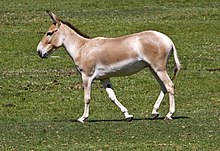Equidae (sometimes known as the horse family) is the taxonomic familyofhorses and related animals, including the extant horses, asses, and zebras, and many other species known only from fossils. The family evolved around 50 million years ago from a small, multi-toed ungulate into larger, single-toed animals. All extant species are in the genus Equus, which originated in North America. Equidae belongs to the order Perissodactyla, which includes the extant tapirs and rhinoceros, and several extinct families.
| Equidae
Early Eocene - Recent[1] | |
|---|---|

| |
| Persian onager | |
| Scientific classification | |
| Domain: | Eukaryota |
| Kingdom: | Animalia |
| Phylum: | Chordata |
| Class: | Mammalia |
| Order: | Perissodactyla |
| Suborder: | Hippomorpha |
| Family: | Equidae Gray, 1821 |
| Subfamilies | |
The term equid refers to any member of this family, including any equine.
The oldest known fossils assigned to Equidae were found in North America, and date from the early Eocene epoch, 54 million years ago. They were once assigned to the genus Hyracotherium, but the type species of that genus is now regarded as a palaeothere. The other species have been split off into different genera. These early equids were fox-sized animals with three toes on the hind feet, and four on the front feet. They were herbivorous browsers on relatively soft plants, and already adapted for running. The complexity of their brains suggest that they already were alert and intelligent animals.[2] Later species reduced the number of toes, and developed teeth more suited for grinding up grasses and other tough plant food.
The equids, like other perissodactyls, are hindgut fermenters. They have evolved specialized teeth that cut and shear tough plant matter to accommodate their fibrous diet.[3] Their seemingly inefficient digestion strategy is a result of their size at the time of its evolution,[4] as they would have already had to be relatively large mammals to be supported on such a strategy.
The family became relatively diverse during the Miocene epoch,[5] with many new species appearing. By this time, equids were more truly horse like, having developed the typical body shape of the modern animals.[6] Many of these species bore the main weight of their bodies on their central third toe, with the others becoming reduced and barely touching the ground, if at all. The sole surviving genus, Equus, had evolved by the early Pleistocene epoch, and spread rapidly through the world.[7]